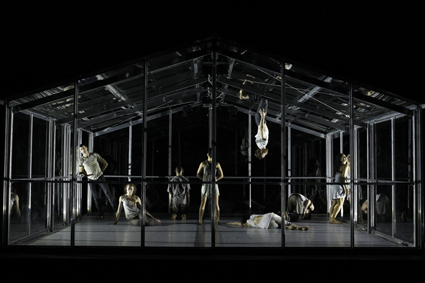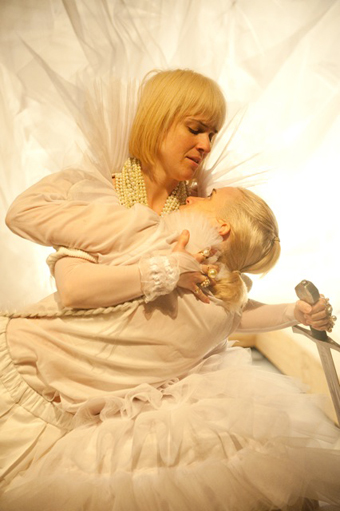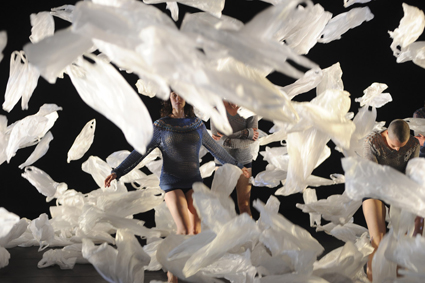world class: twixt exotic & universal
john bailey: 2012 melbourne international arts festival

An Act of Now, Chunky Move
photo Jeff Busby
An Act of Now, Chunky Move
THERE’S A LINGERING WHIFF OF THE CULTURAL CRINGE TO THAT OFT-EMPLOYED PHRASE, ‘WORLD CLASS.’ IT’S SLAPPED ON NEW ARCHITECTURE AND RESTAURANTS, BUT EQUALLY BESTOWED AS A KIND OF HONORIFIC ON CULTURAL ARTEFACTS. IN A PAROCHIAL SENSE, IT SUGGESTS THAT SOMETHING ISN’T JUST GOOD, BUT GOOD ENOUGH FOR ELSEWHERE, WHERE STANDARDS ARE PRESUMABLY HIGHER. IT’S A TERM OF PRAISE THAT CAN ALSO BELITTLE. NOT ALWAYS, OF COURSE.
There’s a realm in which ‘world class theatre’ is a very accurate descriptor—that space occupied by works that consciously seek a diasporic status, and that often address internationalism on both a thematic and contextual basis. Think of Ariane Mnouchkine’s touring productions, or those of the Roberts Lepage and Wilson. These situate themselves in a floating world that may touch down on earth here and there, but never take firm root. They travel well, but sometimes at the expense of a profound engagement with the local.
All of this is a way of thinking through the dilemma of the international arts festival in Australia today. The works that are brought here must strike that balance between the exotic and the universal, be indicators of elsewhere while still speaking to the familiar, and admit of a plurality without losing intelligibility. At the same time, new Australian work presented in a festival context will be (perhaps unconsciously) viewed with a comparative eye—is this of the same quality or kind as its visiting brethren? Is it too Australian? Not Australian enough?
These are usually unhelpful questions, but we ask them. I don’t know how well the range of new Australian work at this year’s Melbourne Festival would travel, but its relationship to the burgeoning economy of global cultural exchange is certainly worth examining.
chunky move, an act of now
Anouk van Dijk’s first production as head of Melbourne’s Chunky Move was a must-see for several reasons. Appropriately titled An Act of Now, it’s a dazzling, immediate production that negotiates continuity and change. An exploration of group dynamics, exploitation, surveillance and the madness of crowds, it makes great demands on its dancers and achieves equally thrilling results.
It’s also an urgent work in the way it manages the expectations of its audiences. Chunky Move is one of the country’s flagship dance companies, and has been pivotal in the incremental development of performance styles that are both distinctive and influential. How these would fare under the stewardship of an incoming choreographer from the Netherlands was always going to be a matter of intrigue. An Act of Now suggests that van Dijk will have an admirable creative impact on the next generation of Australian dance, since the work features much that is strikingly different from the story we’ve seen thus far.
The dancers are locked in a large glass box, greenhouse-like, which is filled with rolling pillows of smoke and lit by invisible sources. They strike poses in sharp silhouette, distinguishable only by things that hint at character—a pair of sunglasses, high heels or brawny broad shoulders. They appear for a moment then melt into invisibility. They’re insubstantial but iconic, unreal but instantly recognisable. It’s a fitting beginning. The next hour or so will demonstrate how the reduction of the individual to an image, so common in the contemporary mediascape, is both dangerous and seductive.
The obvious parallel here is that of a Big Brother house, in both an Orwellian and reality TV sense. The relationships that form between dancers are always made desperate by our scrutiny. Bonds form briefly, but are forever threatened by the lack of control the situation demands. The group turns on a member, pairs isolate themselves, attempt to escape or find some solitude, upset the precarious social balance of the hothouse ecosystem. The audience, meanwhile, exercises its voyeuristic gaze over the proceedings while remaining ultimately disconnected from the interior worlds that are denied us. The transmission of the score via individual headphones also subtly furthers this, separating us from our fellow viewers and the real sounds occurring outside.
If it’s an indicative work, van Dijk’s arrival will prove a positive force in the evolution of Australian dance. The piece is ‘international’ in a sense, since it would fare well in cities across the globe, but that could be said of most of Chunky Move’s previous productions. More interesting is the way it seems aware of the international market without particularly caring about it one way or another—its goals are aesthetically driven, first and foremost.
the rabble, orlando

Mary Helen Sassman, Dana Miltins, Orlando, The Rabble
photo Sarah Walker
Mary Helen Sassman, Dana Miltins, Orlando, The Rabble
The same can be said of The Rabble’s startling adaptation of Virginia Woolf’s Orlando. Its visual language evinces a consciousness of recent trends in post-dramatic theatre around the world, but its impact is utterly of its own voice. The closest referent might be Daniel Schlusser’s gripping eviscerations of classic texts (and Schlusser has worked with the company in the past), but even that comparison diminishes the brave originality on display here.
This is most definitely not Woolf’s Orlando. Where the original tale of a youth who switches gender, lives for centuries and seems unaffected by time’s decay is a love letter that bursts with pleasures and a kind of uncontainable joy, this production does a terrible violence to its source. Both are powerfully feminist visions, but where one celebrates possibility, the other introduces the most monstrous elements of patriarchy into a system that imagined alternatives. Here Orlando is not liberated when she attains her female form, but instead finds herself on the wrong side of a system of oppression to which she herself had previously contributed. This Orlando is rapist, perhaps murderer, victim, mother, hysteric, dunce, clown and much more. Indeed, all of Woolf’s characters are made into carnivalesque grotesques, or robbed of voice, or drawn in mere outline—there is no way of interpreting them in a realist manner, and equally the thicker meanings of this production will be debated by audiences who may each feel they’ve witnessed a different work.
There’s a sculptural quality to the palette—the alabaster surfaces of both set and players could make them marbles stolen from some older culture, but in their whiteness the cast are equally the colonials doing the thieving. There’s also a Catholic dichotomy between the strict and repressive atmosphere and the perverse fascination with an iconography of morbidity and excess.
Like An Act of Now, this Orlando is less remarkable for the way it speaks to its predecessors than for what it points to ahead. The Rabble has been a company to watch for some years, but the daring and acuity of this work is of the sort that indicates a giant stride has been taken, one which other companies will be well-advised to take notice of.
polyglot theatre, how high the sky
Polyglot Theatre’s recent years have been just as compelling. The company has had to adapt to survive, and in this case that’s meant developing a strong touring presence with a travel itinerary that is quite astonishing. I don’t know whether this has anything to do with the sheer level of confidence that must have allowed a work like How High the Sky to even be conceived of, but it’s the kind of so-crazy-it-just-might-work thing that few might even consider attempting.
The production is pitched at three very distinct audiences: babies under a year old, their carers, and a third group of onlookers. To create something that will speak to each of these, who will all have very different investments in the ongoings, is more challenging than may be obvious. To provide engagement with the perceptual psychology of an infant demands a carefully thought-out kind of immersive spectacle, but how compelling will this be for an adult sitting to one side? And what of the parent who is both onlooker and participant?
I don’t profess to any great understanding of babies’ mental worlds, but the youngest audience for How High the Sky gave out a sense of wonder that any work of theatre should be admired for producing. The space is an unfolding sea of balloons big and small, streamers, shifting sound and lightscapes. There’s an undersea aspect to it all, a fluidity and weightlessness. Puppeteers discreetly manipulate the environment and the kids are free to handle their way around the space. Carers are initially seated with the babies, but after some time are invited to move to the sidelines and most surprising of all is the way that the children are by this time so involved with their surrounds that there’s no real sense of separation anxiety.
For the third party onlookers, the responses of the babies are themselves undoubtedly the ‘show’ here, but it’s not some creepy Anne Geddes-style objectification of infants. The babies are not performers, but an audience we’re allowed the privilege of seeing. If anything, the looks on the faces of the children here were a reminder of how rare an aesthetic experience of sheer wonder is for an adult. It’s saddening, but also heartening to be offered a moment of pre-linguistic engagement, if only by proxy.
lucy guerin inc, weather

Weather, Lucy Guerin Inc
photo Heidrun Löhr
Weather, Lucy Guerin Inc
While Lucy Guerin has often employed spoken words in her work, it too often seems to occur in a space outside of language. Rather, sounds produced by vocal mechanics are just another extension of the body itself—the sense of their employment here is not that of reason and discourse but of the physical being of the noises we make. At the same time, Guerin’s choreographic interests have straddled a line between that immanent physicality and cooler, more cerebral constructs that exist almost purely as abstractions.
So while it’s possible to say a lot about things such as climate change, the invisible forces of nature or the effects of the environment on the human form when thinking about Guerin’s Weather, it’s not right to imagine that the work says anything about these concepts. The hundreds of plastic bags that make up the set might allow thoughts of the destructiveness of human waste-making; the hydraulic breathing of an arresting opening solo might suggest our fragile dependence on our atmosphere; but this thinking occurs after the fact, outside of the condition Guerin has created for us. More than most of her peers, I would argue, Guerin works intensely to efface any literalism from her choreography, and to equally subtract a sense of definitive authorial intention through which the dance can be ‘decoded.’
But despite her long and reckonable career, Guerin shares something in common with new and emerging choreographers. There are only a few tiny moments in Weather that gesture to her earlier work; more often it seems that she is trying to find new modes of expression. She’s not one to focus on developing a signature, a consistent style that carries across her body of work. But as with many of her contemporaries, this creates a kind of permanent crisis of creativity. Making it new is easy when you haven’t yet made much to speak of, but attempting not to settle back into familiar routines is a much trickier imperative to artists with decades of experience.
Weather isn’t a showy work, but there are brief sequences that rise up and make an attestable impact. Perhaps the finest impress most because of their simplicity: with the playing space entirely covered in the gently drifting plastic bags, the six dancers lie upon their backs in a row, link arms and slide the length of the stage like a snow plough, shoring up everything in its wake. Again, it doesn’t say anything. Indeed, it doesn’t really create many conscious associations. But it’s a movement that seems to emerge from nowhere, and disappears just as quickly.
–
Melbourne International Arts Festival: Chunky Move, An Act of Now, concept, choreography Anouk van Dijk, composer, sound designer Marcel Wierckx, costumes Anna Cordingley, lighting Niklas Pajanti, performers Peter Cseri, Leif Helland, Stephanie Lake, Lauren Langlois, Paea Leach, Alya Manzart, James Pham, Nina Wollny, Sidney Myer Music Bowl, Oct 18-27; The Rabble, Orlando, after Virginia Woolf, creators Emma Valente, Kate Davis, direction, lighting Emma Valente, design Kate Davis, performers Syd Brisbane, Dana Miltins, Mary Helen Sassman, Malthouse Theatre, Oct 12-27; Polyglot Theatre, How High the Sky, concept Sue Giles, Jessica Wilson, Anna Tregloan, directors Sue Giles, Jessica Wilson, design Anna Tregloan, composer, sound designer David Franzke, lighting Andrew Livingston/Bluebottle3, Arts Centre, Melbourne, Oct 24-28; Weather, director Lucy Guerin, choreography Lucy Guerin with the dancers Talitha Maslin, Alisdair Macindoe, Kirstie McCracken, Harriet Ritchie, Lee Serle, Lilian Steiner, design Robert Cousins, lighting Benjamin Cisterne, composer Oren Ambarchi, costumes Shio Otani, Malthouse, Oct 18-21
RealTime issue #112 Dec-Jan 2012 pg. 15-16






